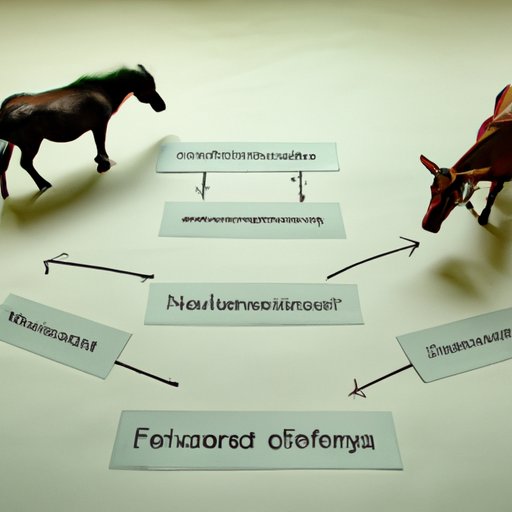Introduction
Financial derivatives are complex financial instruments that are used to manage risk and generate returns. They are contracts between two or more parties that derive their value from an underlying asset such as stocks, bonds, commodities, or currencies. In this article, we will explore what financial derivatives are, how they work, common types, investment strategies, and the pros and cons of investing in them.
A Beginner’s Guide to Financial Derivatives
Financial derivatives are an important tool for managing risk and generating returns. Despite their complexity, they can be easily understood with a basic understanding of their structure and function.
What Are Financial Derivatives?
Financial derivatives are contracts between two or more parties that derive their value from an underlying asset. These assets can include stocks, bonds, commodities, or currencies. The most common types of financial derivatives are futures, options, swaps, and forwards. Each type of derivative has a different structure and purpose, but all are designed to provide investors with the ability to manage risk and generate returns.
How Do Financial Derivatives Work?
Financial derivatives are based on the concept of leverage, which means that investors can control a large amount of an underlying asset with a relatively small amount of capital. For example, if an investor wanted to buy 1,000 shares of a company, they could use a futures contract to purchase the same number of shares with just a fraction of the total cost. This allows investors to take advantage of market movements without having to commit a large amount of capital upfront.
Common Types of Financial Derivatives
Futures: Futures are agreements to buy or sell an underlying asset at a specific price on a future date. They are commonly used by investors to hedge against price fluctuations and/or speculate on the direction of the market.
Options: Options are contracts that give the buyer the right, but not the obligation, to buy or sell an underlying asset at a specific price on a future date. They are typically used by investors to speculate on the direction of the market.
Swaps: Swaps are agreements between two parties to exchange cash flows at predetermined intervals. They are often used by investors to hedge against interest rate or currency fluctuations.
Forwards: Forwards are agreements to buy or sell an underlying asset at a specific price on a future date. They are commonly used by investors to speculate on the direction of the market.

Exploring the World of Financial Derivatives
Investment Strategies Involving Financial Derivatives
Financial derivatives can be used in various investment strategies. For example, investors may use derivatives to hedge against price fluctuations or to speculate on the direction of the market. Investors may also use derivatives to diversify their portfolios or to gain exposure to new markets. Additionally, investors may use derivatives to gain leverage, allowing them to control a larger position with a smaller amount of capital.
The Impact of Financial Derivatives on the Economy
Financial derivatives have had a significant impact on the global economy. According to a study by the International Monetary Fund (IMF), “The growth of derivatives markets has been one of the most remarkable phenomena of the last two decades, with notional amounts outstanding increasing from $10 trillion in 2000 to over $750 trillion in 2018.” The growth of these markets has helped to reduce risk and increase liquidity in the global economy, making it easier for businesses to access financing and allowing investors to diversify their portfolios.
Pros and Cons of Investing in Financial Derivatives
Advantages
One of the main advantages of investing in financial derivatives is that they allow investors to take advantage of market movements without having to commit a large amount of capital upfront. Additionally, derivatives can be used to hedge against price fluctuations and/or speculate on the direction of the market. Finally, derivatives can be used to diversify portfolios and gain exposure to new markets.
Disadvantages
There are also some potential drawbacks to investing in derivatives. The most significant is that derivatives can be highly volatile. If the underlying asset moves in the wrong direction, investors can suffer large losses. Furthermore, derivatives can be difficult to understand and require a certain level of knowledge and experience to trade successfully.
Conclusion
Summary of Financial Derivatives
In conclusion, financial derivatives are complex financial instruments that are used to manage risk and generate returns. They are contracts between two or more parties that derive their value from an underlying asset such as stocks, bonds, commodities, or currencies. Financial derivatives can be used in various investment strategies, such as hedging against price fluctuations, speculating on the direction of the market, diversifying portfolios, and gaining exposure to new markets. However, they can also be highly volatile and require a certain level of knowledge and experience to trade successfully.
Final Thoughts
Financial derivatives can be a powerful tool for managing risk and generating returns. However, they are also complex instruments that require a certain level of knowledge and experience to trade successfully. As such, it is important to do your research and understand the risks involved before investing in any type of derivative.
(Note: Is this article not meeting your expectations? Do you have knowledge or insights to share? Unlock new opportunities and expand your reach by joining our authors team. Click Registration to join us and share your expertise with our readers.)
